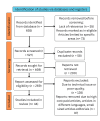A Narrative Review of Retinopathy in Diabetic Patients
- PMID: 38357071
- PMCID: PMC10866186
- DOI: 10.7759/cureus.52308
A Narrative Review of Retinopathy in Diabetic Patients
Abstract
Patients with diabetes may be at risk of ocular diseases, like retinopathy due to diabetes and oedema of the eye. Patients with retinopathy due to diabetes experience constant injury to the retina and the posterior end of the eye, which is light-sensitive. It is a prominent complication faced by diabetics that threatens a patient's vision. Diabetes can inhibit the body's potential to ingest and maintain blood glycemic levels, resulting in several health problems. Excessive glucose in the blood can affect the eyes and other organs of the body. Diabetes has an effect on the blood supply system of the retina over a prolonged period of time. Diabetes-related retinopathy can lead to blindness as fluid can flow into the macula, which is essential for maintaining a clear visual field. The macula, despite its small size, is the region that enables us to comprehend colours and fine peculiarities well. The fluid swells the macula, leading to an impaired visual field. The weak, irregular blood vessels formed during neovascularization can potentially haemorrhage into the posterior end of the eye, obstructing the visual field. Blood vessels of the eye leak blood and other fluids, causing retinal tissue enlargement and eyesight clouding. Typically, the illness affects both eyes. Diabetes retinopathy is more likely to develop as a person's diabetes progresses. If untreated, retinopathy due to diabetes can result in blindness.
Keywords: blindness; diabetes mellitus; diabetic retinopathy; hypertension; photocoagulation.
Copyright © 2024, Gupta et al.
Conflict of interest statement
The authors have declared that no competing interests exist.
Figures
Similar articles
-
Standard threshold laser versus subthreshold micropulse laser for adults with diabetic macular oedema: the DIAMONDS non-inferiority RCT.Health Technol Assess. 2022 Dec;26(50):1-86. doi: 10.3310/SZKI2484. Health Technol Assess. 2022. PMID: 36541393 Free PMC article. Clinical Trial.
-
Vascular permeability in retinopathy is regulated by VEGFR2 Y949 signaling to VE-cadherin.Elife. 2020 Apr 21;9:e54056. doi: 10.7554/eLife.54056. Elife. 2020. PMID: 32312382 Free PMC article.
-
Algorithms for Diagnosis of Diabetic Retinopathy and Diabetic Macula Edema- A Review.Adv Exp Med Biol. 2021;1307:357-373. doi: 10.1007/5584_2020_499. Adv Exp Med Biol. 2021. PMID: 32166636 Review.
-
[Angiopathy and the eye].Vnitr Lek. 2010 Apr;56(4):333-9. Vnitr Lek. 2010. PMID: 20465107 Review. Czech.
-
Diabetic Retinopathy: Clinical Features, Risk Factors, and Treatment Options.Curr Diabetes Rev. 2024;20(7):e271023222871. doi: 10.2174/0115733998252551231018080419. Curr Diabetes Rev. 2024. PMID: 37929721 Review.
Cited by
-
Advances in fecal microbiota transplantation for the treatment of diabetes mellitus.Front Cell Infect Microbiol. 2024 Apr 10;14:1370999. doi: 10.3389/fcimb.2024.1370999. eCollection 2024. Front Cell Infect Microbiol. 2024. PMID: 38660489 Free PMC article. Review.
-
The Calcium Signalling Profile of the Inner Blood-Retinal Barrier in Diabetic Retinopathy.Cells. 2025 Jun 6;14(12):856. doi: 10.3390/cells14120856. Cells. 2025. PMID: 40558483 Free PMC article. Review.
-
Elevated serum lipoprotein(a) levels as a potential risk factor for diabetic retinopathy in type 2 diabetes: a meta-analysis.Int Ophthalmol. 2024 Nov 23;44(1):439. doi: 10.1007/s10792-024-03360-x. Int Ophthalmol. 2024. PMID: 39579229
References
-
- Global prevalence of diabetes: estimates for the year 2000 and projections for 2030. Wild S, Roglic G, Green A, Sicree R, King H. Diabetes Care. 2004;27:1047–1053. - PubMed
-
- Diabetes mellitus and its degenerative complications: a prospective study of 4,400 patients observed between 1947 and 1973. Pirart J. Diabetes Care. 1978;1:252–263.
-
- Two-year outcomes of the ranibizumab for edema of the mAcula in diabetes (READ-2) study. Nguyen QD, Shah SM, Khwaja AA, et al. Ophthalmology. 2010;117:2146–2151. - PubMed
-
- The Wisconsin Epidemiologic Study of Diabetic Retinopathy. X. Four-year incidence and progression of diabetic retinopathy when age at diagnosis is 30 years or more. Klein R, Klein BE, Moss SE, Davis MD, DeMets DL. Arch Ophthalmol. 1989;107:244–249. - PubMed
Publication types
LinkOut - more resources
Full Text Sources


